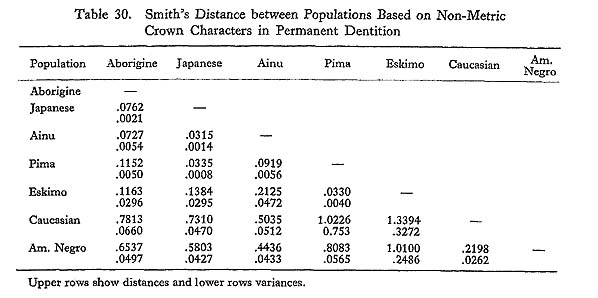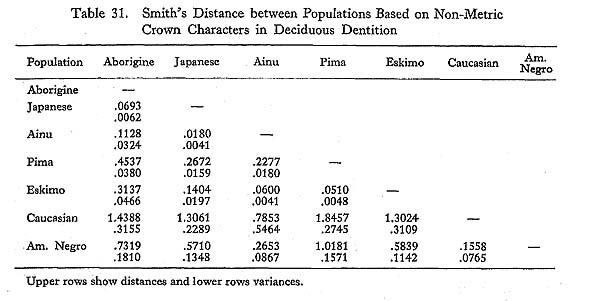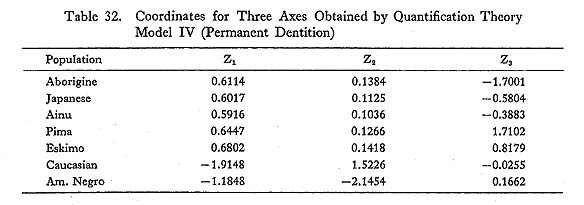5. NON-METRIC TOOTH CROWN CHARACTERS
5.1. Description of Non-Metric Crown Characters Used in the Present StudyIn addition to measurements of the tooth crowns, several non-metric characters which appeared on the crowns may provide important informations in regard to taxonomic problems of human populations. Since 1954 when the author started studies on dental anthropology, he has accumulated data on non-metric characters in the deciduous and permanent dentitions from several populations including Aborigines, and found that their frequency distributions were quite useful to analyse affinities between different populations. Among these, the most remarkable characters are those which are called 'Mongoloid dental complex' (Hanihara, 1966, 1967, 1968, 1970) and the Carabelli's cusp. The Mongoloid dental complex is composed of five crown characters which characterize the Mongoloid dentition in their higher frequency distributions than in the other populations, and, on the contrary, the Carabelli's cusp appears more frequently and predominantly in the Caucasians compared to the other populations. In the permanent dentition the five crown characters that compose the Mongoloid dental complex are: shovel-shaping in the maxillary central incisors, cusp 6, cusp 7, deflecting wrinkle and protostylid in the mandibular first molars; while in the deciduous dentition they are the same characters in the deciduous maxillary incisors and the deciduous mandibular second molars. In the deciduous dentition, frequency of the Carabelli's cusp was calculated from those in the deciduous maxillary second molars. There is another problem in observing non-metric characters in regard to criteria for classification. In the present study the teeth which carry the corresponding characters were distinguished from non-carriers in the following manner: 1) Shovel shape —This character has so far been classified into some categories such as no-shovel, slight-shovel, moderate-shovel, etc., through non-metric observations. However, the most ideal way to measure the extent of shovelling might be to make a direct measurement of depth of the lingual fossa in the incisors. For this purpose, as already described in Section 4.1.3 of this paper, the author used a dial gauge with a pair of movable arms to measure the extent of shovelling in the maxillary central incisors. In the present study, the teeth with the lingual fossa which equals to or less than 0.5 mm depth were classified into 'no-shovel', and those which are deeper than 0.5 mm into carriers of the shovel trait. On the other hand, since the depth of the lingual fossa is generally much smaller in the deciduous maxillary central incisors than in the permanent incisors, no direct measurement was made for them. Instead of this, each tooth was compared to the Plaque D1 which was prepared to classify the shovelling in the deciduous maxillary central incisors (Hanihara, 1961). This plaque illustrates four developmental stages of the shovel traits by attaching figures 0 through 3: 0 for no-shovel, 1 for trace- or semi shovel, 2 for moderate-shovel, and 3 for strong-shovel. In the present study, the teeth classified into stages 0 and 1 were combined and referred to as 'no-shovel', and those classified into stages 2 and 3 were joined together to make another category of 'shovel'. The reason for such a simplification is based on the fact that the former group of teeth may, through genetic analysis of the Japanese-American F1 hybrids, be regarded as non-carriers and the latter groups as carriers of this trait (Hanihara, 1965). The morphological differences between stages 0 and 1 as well as between 2 and 3 may thus be considered to be accidental variations caused by non-genetic factors. 2) Cusp 6 —This cusp is one of the extra cusps which appears occasionally between the entoconid and hypoconulid in the permanent and deciduous mandibular molars. The incidence of this cusp has been studied by several investigators and regarded as a racial characteristic (Hellman, 1928; Dahlberg, 1945; Tratman, 1950; Suzuki and Sakai, 1956; Hanihara, 1966, 1968; etc.). Distinction of carriers and non-carriers of this trait is quite easy, so that the teeth with this cusp were simply counted as carriers regardless of size. 3) Cusp 7 —This is another extra cusp which is located at the marginal border between the metaconid and the entoconid. This cusp was originally described by Selenka (1898) who proposed the term tuberculum accessorium mediale internum, and reported many incidences by several subsequent authors in the fossil and recent primates including man. For instance, de Terra (1905) reported frequencies of this cusp in the permanent mandibular molars of recent man, and Suzuki and Sakai (1956) made a statistical investigation in Japanese. On the other hand, the cusp in the deciduous mandibular molars was reported by Robinson (1958), Jørgensen (1956), Hanihara and Minamidate (1965), Hanihara (1966, 1967, 1970), etc. In the permanent mandibular first molars, the cusp 7 appears in relatively rare cases, but its expression is quite evident. According to Suzuki and Sakai (1965), the cusp 7 appears to be stemming from the metaconid in most of the cases, but rarely it may be regarded as branching from the entoconid. In the present study, both cases were counted as carriers of this trait in the permanent mandibular first molars. On the other hand, the cusp 7 appears to vary its expressivity continuously in the deciduous mandibular second molars. On the basis of this fact, the Plaque D9 (see Hanihara, 1961) illustrates four stages of this cusp which were arranged in a serial order from absent (stage 0), through trace (stage 1) and medium (stage 2), to welldeveloped (stage 3). In this study, as in the case of the shovelling in the deciduous maxillary central incisors, each tooth was classified into the corresponding stages by comparing to the Plaque D9 to warrant objectivity of the classification, and the teeth classified either into stages 1, 2 or 3 were referred to as carriers of this trait. 4) Deflecting wrinkle —The deflecting wrinkle is one of the particular formations of the median ridge of the metaconid. The ridge, when the deflecting wrinkle appears, shows a stronger development in either its length or breadth and curves distalward at the central part of the occlusal surface. This character was first described by Weidenreich (1937, 1945) in his papers on Sinanthropus and Gigantopithecus, and subsequently, von Koenigswald (1952) drew attention to the deflecting wrinkle appeared in the deciduous mandibular molars in modern Javanese. In addition, the frequency distribution of this character in Japanese per manent molars was reported by Suzuki and Sakai (1956) and those in Japanese per manent and deciduous molars by Hanihara et al, (1964) and Hanihara (1970). According to Hanihara, Kuwashima and Sakao (1964), there are considerably wide range of varieties in appearance of the deflecting wrinkle. For instance, in some cases, the wrinkle is of relatively simple form in which the median ridge of the metaconid is well-developed but deflected little, whereas in the other cases, the ridge is typically deflected at almost a right angle. In the present study, only the teeth with the wrinkles which deflected at about a right angle were referred to as carriers of this trait, and those showing little deflection were disregarded even if the median ridge was well-developed. This rule was applied to permanent and deciduous mandibular molars in common. 5) Protostylid —The term protostylid was first proposed by Dahlberg (1945, 1949, 1950) for a swelling or an extra cusp found on the buccal surface of the protoconid in the mandibular molars. The original author reported extremely high frequencies of this character in Pima Indians in comparison with the other populations in which it is only rarely observed. Later, Suzuki and Sakai (1954) found fairly frequent appearance of the protostylid in the mandibular molars of Japanese. These findings proved that the protostylid occurred very rarely in the dentition of modern man with the exception of some particular populations such as mentioned above. In his studies of the deciduous dentition, Hanihara (1956, 1966) reported that the protostylid was relatively frequently observed in the deciduous mandibular second molars, though it showed generally less degree of prominence compared with the permanent molars. The same author (1968) also reported frequencies of this extra cusp in some different populations, and found significant difference between Mongoloids and other populations. Although there are many varieties in expression of the protostylid, the author counted, in the present study, only those teeth which showed a more or less extent of swelling on the buccal surface as carriers of this trait, the so-called pit or furrow type having been omitted from calculation of frequencies. 6) Carabelli's cusp —It is well known that the Carabelli's cusp frequently appears in Caucasoids and relatively infrequently in non-Caucasoid populations. At the same time, the cusp is generally well developed in the former populations. In this connection, this cusp is not included in the Mongoloid dental complex described above, but it rather characterizes Caucasoid populations in its higher frequencies. There are again several varieties in its appearance as illustrated by Dahlberg's Plaque P12 for permanent dentition and by Hanihara's Plaque D7 for deciduous dentition (Hanihara, 1961). In the present study, however, those forms which are separated from the lingual surface by a groove and, as a result, possess a more or less free apex were counted for statistical procedures. Such a method of classification may provide a reasonal basis to distinguish the Caucasoids from the other populations. 5.2. Frequencies of Non-Metric Crown Characters in the Permanent DentitionTable 28 gives percentile frequencies of each crown character in the seven populations on which observations were made by the present author. Although there are a number of similar data reported by previous authors, comparison was carried out only for the above populations because criteria for classifying characters might have been more or less different one another. The data shown here are those from males and females in combination since no between-sex difference was observed.
For the shovel-shaped character in the maxillary central incisors, there is a distinct difference between the Caucasian-American Negro group and the rest of the populations. In particular, considerably high frequencies are shown by Japanese, Pimas and Eskimos, and a little less frequencies by Aborigines and Ainu. Frequencies of the cusp 6 show again a distinct contrast between the former and the latter groups of populations. In this character, however, Aborigines represent the highest frequency which is followed by Eskimos, and it is of interest to note that Japanese, Ainu and Pimas show almost the same frequencies. In regard to the cusp 7, American Negroes show the highest frequency which is largely different from those of the other populations. As described later, difference in frequencies of this character is much greater in the deciduous molars. The deflecting wrinkle appears quite frequently in Aborigines, Pimas and Eskimos, a little less in Japanese and Ainu, and relatively rarely in Caucasians and American Negroes. Frequencies of the protostylid are the highest in Eskimos followed by Pimas, and relatively low in Aborigines, Japanese and Ainu. In Caucasians and American Negroes practically no incidence of this character was observed. As already mentioned above, the Carabelli's cusp shows different trends from the other characters just described. The incidence of this character is the highest in Caucasians and much less in the other populations. Among the latter, however, Aborigines and American Negroes show relatively high frequencies of the Carabelli's cusp in. comparison with Japanese, Ainu and Pimas, Eskimos being located in between. As a whole, Aborigines are similar to the Mongoloid populations in frequency distribution of the crown characters which compose the Mongoloid dental complex. In the Carabelli's cusp, however, the frequency in Aborigines is almost equal to that of American Negroes and intermediate between those of the Mongoloids and Caucasians. 5.3. Frequencies of Non-Metric Crown Characters in the Deciduous DentitionTable 29 gives percentile frequencies of non-metric crown characters in the deciduous dentition. As in the permanent dentition already described, the populations observed by the present author were compared.
For the shovel-shaping character in the deciduous maxillary central incisors, there is a clear-cut difference between the upper five populations in Table 29 and the lower two populations, in spite of small numbers of samples in some populations. This trend is quite similar to that of the permanent dentition. Almost the same results are obtained from the data for the cusp 6. It is remarkable that frequency in Aborigines is much higher than in the other populations. The same result is also reported by Kuusk (1973) who obtained frequency of 65.0% out of 177 deciduous mandibular second molars in Aborigines. The deflecting wrinkle is also as frequent in Aborigines as in the Mongoloid populations. The frequencies are almost equal in these populations but much less in Caucasians and American Negroes. The protostylid is most frequently observed in Pimas as reported by Dahlberg (1949), and a little less in Eskimos. Aborigines show a similar frequency to Japanese and Ainu, and Caucasians and American Negroes show less frequencies. As in the permanent maxillary first molars, the incidence of the Carabelli's cusp is the highest in Caucasians and a little less in Aborigines. Japanese, Ainu and American Negroes show nearly equal frequencies and the cusp is practically absent in Pimas and Eskimos. In general, trends observed in the deciduous dentition are quite parallel to those of the permanent dentition with a small discrepancy between them. To evaluate such similarities, correlation coefficients were calculated on the basis of frequencies in the deciduous and permanent dentitions. The coefficients are 0.91 for shovel-shaping, 0.88 for cusp 6, -31 for cusp 7, 0.88 for deflecting wrinkle, 0.86 for protostylid, and 0.81 for Carabelli's cusp. Of these only the correlation coefficient for the cusp 7 is insignificant and the rest of the coefficients are significant under the 5% level. The result in the cusp 7 is very likely caused by a remarkably higher frequency in American Negro permanent molars. Comparison of Tables 28 and 29 shows that the difference in frequencies between Mongoloids and other populations are much more remarkable in the deciduous dentition than in the permanent dentition. From this fact it may be assumed that the deciduous dentition preserves generalized characters to a larger extent than the permanent dentition, and the latter provides more informations in regard to specificity of each population than the former. In this respect, Aborigines seem to be closer to Mongoloids than to Caucasians and American Negroes. However, there are some characters whose frequencies are predominantly high in Aborigines and, in the other characters, they are intermediate between both extreme cases. In this connection, it is quite difficult to postulate general affinity of Aborigines from direct comparison of frequencies of each character involved. 5.4. Affinities of Populations Viewed from Biological Distance Based on the Non-Metric Crown CharactersA considerable number of methods which determine the biological distance based on non-metric characters, or qualitative variables, have so far been proposed. Among these, the most suitable methods for the present study may be those devised by R. A. Fisher and C. A. B. Smith (Berry and Berry, 1967; Constandse-Westermann, 1972). In particular, Smith's method has some advantages over Fisher's method in providing more evident difference between populations and ease of test of significance. According to Berry and Berry (1967), the distance will be significant at the 0.05 probability level if it is greater than three times of variance, and at the 0.01 level if it is greater than six times of variance. The original equations for calculating distance coefficient (D) and its variance (V) given by Smith are: However, these forms do not allow the use of sample numbers which differ for each trait under consideration. To obtain distance coefficients and their variances based on different sample numbers the above formulae should be modified as follows (Hanihara et al.,1974): In Tables 30 and 31 distances and variances computed by the equations (3) and (4) for permanent and deciduous dentitions are shown. Every distance coefficient is larger than three times of variance so that all of them are significant under the 5% level, or even under the 1% level in some cases.
It is quite evident that Aborigines show a very close affinity to the Mongoloid populations in both permanent and deciduous dentitions, but are very far from Caucasians and American Negroes. These results are quite different from those of the crown measurements described in the previous chapter. It is no wonder, however, that the results from the metric and non-metric characters are different each other. Existence and non-existence of certain crown characters, the Cusp 6 in the deciduous mandibular second molars, for example, show practically no correlation with the mesiodistal crown diameters of the same teeth (r = 0.25, DF = 58; Hahihara, unpublished data). On the other hand. Smith's distances in the deciduous and permanent dentitions show quite similar trends each other. Correlation coefficient between distances for both dentitions is 0.85 (DF=19) and this is highly significant at the 0.01 probability level (Figures 10 and 11). This shows clearly that frequencies of the crown characters involved vary quite similarly in the permanent and deciduous dentitions within the same population.
From the distances shown in Tables 30 and 31, clustering of populations is not necessarily easy because each population is scattered in a six-dimensional space. However, affinities between populations may be roughly expressed by a dendrogram if minor contradictions can be disregarded. For the permanent dentition, a dendrogram like that shown in Figure 12 may be drawn using a usual technique of clustering. In the same manner, another dendrogram for the deciduous dentition can be drawn as shown in Figure 13. Both dendrograms are almost the same in shape, and this is quite natural because the distance coefficients are, as mentioned above, quite similar to each other in the permanent and deciduous dentitions.
For clustering populations, another statistical technique may be employed. Since the distances calculated are those in a multi-dimensional space, relative location of each population may be hardly comprehensive. To reduce such difficulties, statistical treatment based on model IV of quantification theory was employed. This model has been proposed by Hayashi (1952,1954) to express affinities among several catagories, or populations in the present case, in a space of reduced dimensions. In the present study, reciprocals of Smith's distances were used as parameters which represent affinities between populations. The final scores are shown in Tables 32 and 33, and Figures 14 and 15 were drawn by using the first two scores (Z1 and Z2) as coordinates for each population. Geometrically speaking, this procedure means that, in the present case, the populations scattered in a six-dimensional space are projected to a two-dimensional space with a minimum loss of informations.
It may be easily assumed from Tables 32 and 33 that, in both deciduous and permanent dentitions, Caucasians and American Negroes occupy quite different locations from each other and from the rest of the populations. On the other hand, the latter five populations are located very close to each other as they would represent a single cluster. This is clearly shown in Figures 14 and 15. However, it is of interest to note that clustering may become quite easy if we pay attention to the third scores (Z3). The Z3-values for the first five populations seem to distinguish the following three clusters: Aborigines, Japanese-Ainu, and Pima-Eskimo clusters (Figures 16 and 17).
From what we mentioned above, it may be concluded that 1) Caucasians and American Negroes are apparently separated from each other as well as from the rest of the populations involved, so that each of the former two populations may be supposed to compose different clusters, and 2) Aborigines, Japanese, Ainu, Pimas and Eskimos are very closely located, but if we pay an attention to the Z3-scores, it becomes evident that three clusters can be distinguished: Aborigine cluster, Japanese-Ainu cluster, and Pima-Eskimo cluster. These results are quite agreeable with Figures 12 and 13 which were drawn by rather elementary clustering techniques. At the same time, it may be noteworthy that the clusters thus established agree with geographical relationship of populations involved, although the Aborigine cluster is very close to those of Mongoloids in terms of biological distance. |
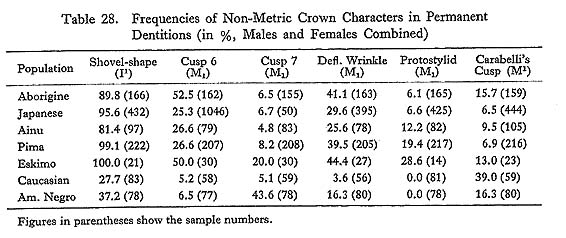
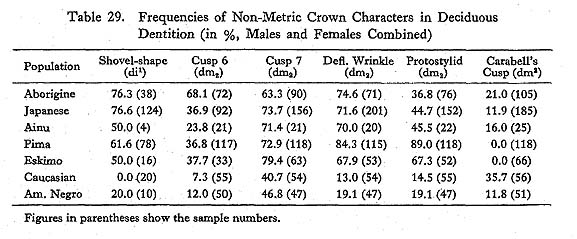
 (1)
(1) (2)
(2) (3)
(3) (4)
(4)